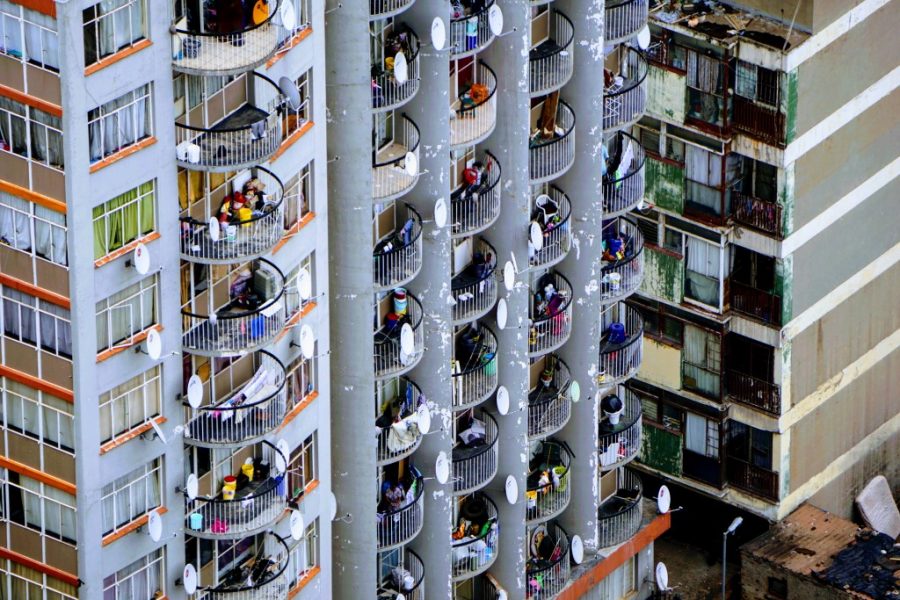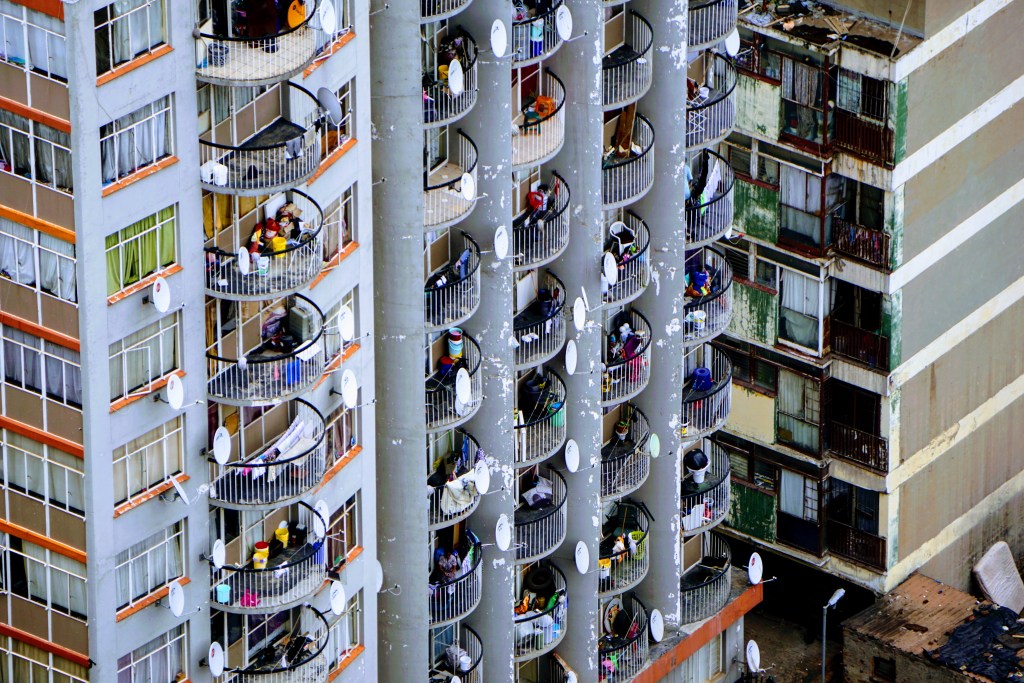OK, obviously Sifiso is so badass that he doesn’t need weapons. I assume he can dismantle another human being with his bare hands in under 3 seconds. This man is either incredibly confident in his combat abilities or incredibly insane. Either one was fine with me.
The tour started when Sifiso brought us into an elevator and up to the 51st floor. I couldn’t wait to look down onto all the crime going on below.
On the way up, Sifiso explained that there were 2 additional floors that weren’t accessible via the elevator. They were originally created for black domestic workers, and because apartheid was in full swing right about that time, nobody thought they deserved to ride in an elevator. And this was about the least of the terrible things apartheid wrought, but that’s a story for another day.
I ran up to the window, camera ready to capture some crime in action and become YouTube famous. And sure enough, I caught…. this?

And this.

The craziest thing we ended up seeing was an overabundance of DSTV (satellite) dishes crammed onto rooftops.

Sifiso sat us all down to give us a brief history of the area. And thus started the obliteration of all my pre-conceived notions of Hillbrow.
First, apparently we weren’t actually in Hillbrow yet. We could SEE it, but Ponte Tower is actually in Berea. Wherever we were, the views were stunning. We could see Sandton and Midrand, and Sifiso told us on a clear day you can see all the way to Pretoria.
Hillbrow used to be a popular white, middle-class neighbourhood in the apartheid era. Because the government then was horrific and awful, they banned inter-racial relationships and had a temper tantrum when people in Hillbrow had the nerve to love other people, regardless of skin colour.
So the powers that be shut off power and water to the entire area to teach these people who dared to be open-minded a lesson. In no time at all, Hillbrow, unsurprisingly because of the lack of service delivery, turned into the Hillbrow that everybody imagines. This is obviously a very condensed version, but that pretty much sums it up.
Sifiso told us the windows in the building were hilariously unsafe, and even though Ponte Tower is very, very tall (173m), a small child had leaned on one of the interior windows and fallen to his very tragic death. I told Sifiso that that kind of information would have been very useful to know BEFORE we all leaned against the windows to take pictures on our way up, but he just laughed and said he was pretty sure they were mostly probably all fixed by now maybe. Thanks Sifiso.
Though we sat in the apartment for about an hour, it went by incredibly quickly. Sifiso obviously loves the neighbourhood, the people, and his job, and he’s an expert at keeping people engaged throughout, interspersing entertaining anecdotes with interesting information about the tower and surrounding area.
I won’t repeat everything he said, but this blog post does a great job of telling the Ponte story.
Along with the incredible view, there were also books, art, and a small selection of clothing (all made by local artists) for sale.

We had a few minutes to take a few more pictures before we headed downstairs. So that’s what we did.


Before we actually began our tour of Hillbrow, Sifiso took us into the centre of Ponte Tower, which is arguably one of the most photogenic locations in the city.

Before efforts were made to rejuvenate the area, there was no service delivery in Ponte Tower, which meant residents would simply throw their waste into the centre of the tower.
The result was the first 13 floors were completely filled with garbage, rats, and the occasional human corpse. It was a monumental effort to get it all cleaned out when they decided to make the building a desirable living space again.

It was really cool to be standing in the centre of such a famous building, and we obviously took a lot of pictures.




After everyone indicated that I was done taking pictures, we walked outside to see the neighbourhood, at which point Grant and Khali joined us.
The three guides took turns telling us about what we were seeing and constantly impressed us with their knowledge and ability to engage us.



As we made our way to our first stop, Grant asked us not to take any pictures at this particular spot. Although there have been many efforts to clean up Hillbrow, there are still over 200 hijacked buildings in Johannesburg.
Essentially, the owners have given up and criminals take over, charging rent to people who can’t afford anything else. But there’s no water, no maintenance, no nothing. The buildings are literally falling apart and covered in garbage.
Grant said that the whole point of the tour is to change people’s perceptions of the notorious neighbourhood, not perpetuate the notion that it’s all derelict buildings (because it isn’t – not by a long shot). And anybody can find pictures of the seedy part of Hillbrow online anyway. Fair enough. I’ve got no desire to take part of the “poverty tourism” industry and am fully on board with Dlala Nje’s mission to show the best of the city.
As we moved along, what struck me most was that the area was relatively clean. With the exception of the few hijacked buildings, it was clear the residents took pride in their streets. Of course some areas looked better than others, but this could be any where in South Africa. Certainly not the notorious Hillbrow!

Our guides showed us security cameras strategically placed throughout the neighbourhood. Because of the constant surveillance, it’s rare for criminals to actually get away with any obvious crime. Pickpocketing is still common because that’s difficult to pick up on the cameras, but there’s a real sense of community in Hillbrow, and if people run into trouble, it’s quite common for bystanders to intervene and beat the friggin daylights out of the criminals.
We stopped outside a German beer garden, and our guides asked who wanted to take a look inside. I wanted to do more than look, and I promised I could down a cold beer in less than a minute. At that point, Grant explained that it wasn’t actually a beer garden, but a brothel disguised as a beer garden. I claimed I could still be done in under a minute, but apparently there were other sights to see.

We carried on through a local park and to the place residents find jobs and rooms to rent.

In many cases, shared beds were advertised. Because money isn’t something many people in this area have in abundance, it’s not uncommon for people working different hours to take turns sleeping in the same bed.
While we were there, one woman asked us for employment, and a man came up and took a picture with us to prove he saw white people in Hillbrow. Both were incredibly friendly, and at no point did we feel threatened.

As we wandered up and down the streets, Grant, Sifiso, and Khali kept us entertained with lively conversation and happily answered both our good and absolutely stupid questions.
Our last stop was at a local shebeen. Shebeens started out as alternatives to bars and pubs, from which black people were barred during the apartheid years, and served as alternative drinking establishments.
I FINALLY got my much-anticipated beer (which I managed to polish off quicker than our German companion who boasted of his country’s legendary drinking abilities, showing him that Canadians aren’t to be trifled with), and we ate some chicken, some other unidentified meat, some other stuff, and some other stuff. It wasn’t gourmet, but we all really enjoyed it.

At the end of the table, a couple of older men sat with their drinks, just enjoying being old men in a shebeen. I excused myself briefly and brought them both a refill (Castle Lager for one, Savanna Cider for the other) and sat down to chat with them for while. Both were incredibly friendly, and if I had more time, I could have easily killed a couple of hours with them.
Unfortunately, we had to move on. On the way back, the guides answered any remaining questions we had, and I’m not exaggerating when I say they already felt like old friends.

I’ve been fortunate enough to have many amazing experiences in South Africa so far, but the Hillbrow Tour with Dlala Nje ranks in the top 2 (Kruger Park will always be my favourite).
I want to be perfectly clear: I’m not naive enough to assume Hillbrow is an absolutely safe place to hang out without keeping your wits about you. It’s still a rough neighbourhood.
But it’s recovering from a very tumultuous past, and the efforts the community is making to transform the area are noticeable. With these efforts, and those of the dedicated team at Dlala Nje, I’m confident that before we know it, this already vibrant suburb will no longer be the place everybody avoids.
I can’t thank the guides enough for giving us an incredible afternoon.


If you go:
- Tours can be booked here
- Wear comfortable shoes
- Don’t go if you’ve recently had foot surgery
- At the time I went (January 2019), the cost was R350 per person, which includes lunch and a drink
- They claim the tour is 3 hours. Ours was closer to 4. No complaints here.
- The walk is approximately 3km
By Phil Maloney
(If you liked this post, don’t forget to sign up to Phil’s mailing list here so you never miss another post again! While you’re at it, you can like the Maple and Marula Facebook page here, the Maple and Marula Instagram here, and follow Maple and Marula on Twitter here)




